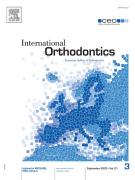Assessment of the possible synergetic effect of micro-osteoperforations and injectable platelet-rich fibrin on the rate of maxillary canine retraction of young adults: A split-mouth randomized controlled clinical trial - 11/04/25

Summary |
Introduction |
This study primarily aimed to evaluate the combined impacts of micro-osteoperforations (MOPs) and injectable platelet-rich fibrin (I-PRF) on the rate of maxillary canine retraction. Additionally, it explored the side effects of the related rotation, tipping, and vertical movements.
Material and methods |
All patients who met the eligibility criteria (Class II Division 1 malocclusion, mild to moderate crowding, bilateral Class II canines, good oral hygiene, and requiring therapeutic extraction of the maxillary first premolars) between April and December 2021 were recruited. This included 25 young adult orthodontic patients (19 females and 6 males). One side of the maxillary arch was randomly chosen to receive MOPs combined with I-PRF, forming the experimental group. In contrast, the other side received only MOPs, serving as the control group. The maxillary canine retraction rate was measured every 4 weeks over a 24-week follow-up period (T0 [before canine retraction] – T6 [after 24-week]). Additionally, canine rotation, intrusion/extrusion, and tipping were evaluated using cone-beam computed tomography (CBCT) before and after retraction at two-time points (T0 and T6). The independent t-test was used to compare the experimental and control groups. Comparisons between stages from T0 to T6 were completed using the t-test for paired samples and repeated measure analysis of variance (ANOVA). The P-values were adjusted using Bonferroni correction.
Results |
This study analysed 25 young adult patients (19 females and 6 males; average age 20.47±4.1 years). The rate of maxillary canine retraction was significantly different between the experimental and control sides, with an overall rate of 1.25±0.28 and 0.75±0.1mm/month (P=0.04, q=0.006), respectively. This significantly faster rate occurred at T1–T2 and T4–T5 time points on the experimental compared to the control side. Canine tipping was also greater in the experimental side, at 3.89±0.19° than in the control side, at 1.80±0.12° (P=0.03, q=0.005). No significant differences were found in maxillary canine rotation, extrusion, or intrusion between the two sides.
Conclusion |
The combination of MOPs and I-PRF demonstrated a synergistic effect, significantly accelerating orthodontic tooth movement during maxillary canine retraction within 6 months of a clinical evaluation, but also with a significant tipping movement.
Le texte complet de cet article est disponible en PDF.Keywords : Accelerated orthodontics, Micro-osteoperforations, Platelet-rich fibrin, Canine retraction, Split-mouth
Plan
Vol 23 - N° 3
Article 101006- septembre 2025 Retour au numéroBienvenue sur EM-consulte, la référence des professionnels de santé.
L’accès au texte intégral de cet article nécessite un abonnement.
Déjà abonné à cette revue ?

